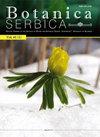Chemical analysis and biological activity of the essential oils and extracts of two liverwort species growing in Turkey
IF 1.1
4区 生物学
Q4 PLANT SCIENCES
引用次数: 1
Abstract
The aim of this study was to investigate the chemical composition of the essential oils (EOs) from two Diplophyllum species and to evaluate their bioactivity potential [antimicrobial, antioxidant, anti-urease, anti-xanthine oxidase (XO)], and phenolic compounds. The analysis of Diplophyllum albicans and Diplophyllum taxifolium permitted the identification of 62 components, comprising ? 99.6% of the total EO composition. The major components found in these liverwort species were ?-patchoulene, ?-santalene, ?-himachalene, and cubebol. The antimicrobial assays showed that the solvent extracts (n-hexane and methanol) from these liverwort species exhibited weak to moderate antimicrobial activity. In addition, the methanol extracts of these liverwort species also exhibited moderate to high antioxidant potential. The enzyme inhibitory effects of the species were determined using urease and XO for the methanol extracts. Generally, the methanol extracts of D. albicans and D. taxifolium exhibited powerful urease inhibition with IC50 values of 9.711 ?} 0.058 and 6.304 ?} 0.099 ?g/mL, respectively, compared to the IC50 value of 26.124 ?} 0.077 ?g/mL for the standard (acetohydroxamic acid). Moreover, the HPLC-UV detection method showed that the analysed methanol extracts of these liverwort species contained only catechin and benzoic acid. These findings suggest that the analysed liverwort species possess antioxidant and urease inhibition, thus indicating the potential to explore new bioactive molecules.土耳其两种苔属植物精油及提取物的化学分析及生物活性
本研究的目的是研究两种龙柏属植物精油(EOs)的化学成分,并评价其生物活性潜力[抗菌、抗氧化、抗脲酶、抗黄嘌呤氧化酶(XO)]和酚类化合物。对白叶复叶和杉木复叶的分析鉴定出62种成分,其中含有?占总EO组成的99.6%。在这些苔属植物中发现的主要成分是-广藿香烯、-桑塔伦烯、-喜马查伦烯和立方烷。抑菌试验表明,这些苔类植物的溶剂提取物(正己烷和甲醇)具有弱至中等的抑菌活性。此外,这些苔类植物的甲醇提取物也表现出中高的抗氧化能力。用脲酶和XO对甲醇提取物进行酶抑制作用测定。总的来说,白念珠菌和紫杉醇甲醇提取物的IC50值分别为9.711±0.058和6.304±0.099 g/mL,而标准品(乙氧肟酸)的IC50值为26.124±0.077 g/mL。此外,HPLC-UV检测表明,所分析的这些苔属植物甲醇提取物仅含有儿茶素和苯甲酸。这些发现表明所分析的苔类具有抗氧化和脲酶抑制作用,从而表明了探索新的生物活性分子的潜力。
本文章由计算机程序翻译,如有差异,请以英文原文为准。
求助全文
约1分钟内获得全文
求助全文
来源期刊

Botanica Serbica
Agricultural and Biological Sciences-Plant Science
CiteScore
1.40
自引率
12.50%
发文量
17
审稿时长
34 weeks
期刊介绍:
Botanica Serbica publishes original research papers on all aspects of plant, fungal and microbial biology research including the disciplines of microbiology, mycology, lichenology, bryology, flora, vegetation, biogeography, systematics, taxonomy, plant biotechnology, plant cell biology, plant ecology, environmental plant biology, forestry, genomics, horticulture, limnology, metabolomics, molecular biology, proteomics, virology, plant conservation and protection, and wildlife and ecosystem management.
 求助内容:
求助内容: 应助结果提醒方式:
应助结果提醒方式:


